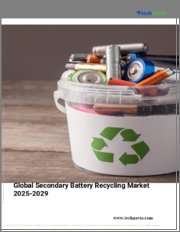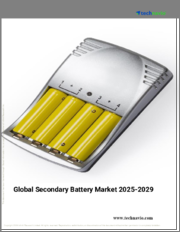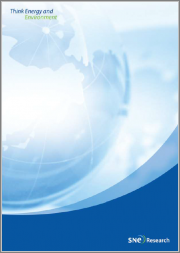
|
시장보고서
상품코드
1519776
2차 전지 시장 보고서 : 유형별, 용도별, 업계별, 지역별(2024-2032년)Secondary Battery Market Report by Type (Lead Acid, Lithium-Ion, Nickel Metal Hydride, and Others), Application, Industry Vertical, and Region 2024-2032 |
||||||
세계의 2차 전지 시장 규모는 2023년에 1,173억 달러에 달했습니다. 향후 IMARC Group은 2024-2032년 성장률(CAGR)이 9%를 보이며, 2032년에는 2,579억 달러에 달할 것으로 예측하고 있습니다.
2차 전지는 화학 에너지를 저장하고 요구 사항에 따라 전기 에너지로 변환하는 축전지 또는 충전식 배터리입니다. 2차 전지는 경제적이며, 1차전지보다 높은 출력 밀도, 적당한 방전 속도, 저온 성능을 제공합니다. 그 결과 전자기기, 휴대폰, 하이브리드 전기자동차(HEV)의 전원으로 사용되고 있습니다. 현재 여러 제조업체가 새로운 2차 전지를 출시하고 있으며, 예를 들어 넓은 유역을 사용하여 저렴한 가격으로 대규모(GWh) 에너지 저장을 가능하게 하는 플로우 배터리가 있습니다.
2차 전지 시장 동향 :
세계적인 인터넷 보급과 소비자의 구매 욕구 증가로 인해 휴대폰, 스피커, 노트북 등 휴대용 전자제품의 판매 증가는 시장 성장을 강화하는 중요한 요인 중 하나입니다. 또한 기존 자동차 관련 온실가스(GHG) 배출에 대한 개인들의 인식이 높아지면서 전기자동차(EV) 동향가 부상하고 있는 것도 시장 성장에 기여하고 있습니다. 이는 여러 국가의 정부가 전기자동차 제조업체에 제공하는 세제 혜택과 보조금에 기인합니다. 이 외에도 재생 에너지에 대한 투자 증가, 효율적인 에너지 저장 장비에 대한 수요 증가, 낮은 2차 전지 유지보수 비용 등이 시장을 촉진하는 주요 요인으로 작용하고 있습니다. 이와 더불어, 급속한 도시화로 인한 전 세계 에너지 소비 증가와 잦은 전력 공급 중단 사례 증가는 전력 백업용 2차 전지에 대한 수요를 자극하고 있습니다. 또한 2차 전지는 최소한의 스트레스로 초고속 충전이 가능하고 높은 비에너지로 인해 전 세계 전동 공구, 의료기기, 항공 및 산업 용도에 널리 채택되고 있습니다.
목차
제1장 서문
제2장 조사 범위와 조사 방법
- 조사 목적
- 이해관계자
- 데이터 소스
- 1차 정보
- 2차 정보
- 시장 추정
- 보텀업 어프로치
- 톱다운 어프로치
- 조사 방법
제3장 개요
제4장 서론
- 개요
- 주요 업계 동향
제5장 세계의 2차 전지 시장
- 시장 개요
- 시장 실적
- COVID-19의 영향
- 시장 예측
제6장 시장 내역 : 유형별
- 납축전지
- 시장 동향
- 시장 예측
- 리튬이온(Li-ion)
- 시장 동향
- 시장 예측
- 니켈 수소
- 시장 동향
- 시장 예측
- 기타
- 시장 동향
- 시장 예측
제7장 시장 내역 : 용도별
- 일렉트로닉스
- 시장 동향
- 시장 예측
- 자동차
- 시장 동향
- 시장 예측
- 산업용 배터리
- 시장 동향
- 시장 예측
- 휴대용 디바이스
- 시장 동향
- 시장 예측
- 기타
- 시장 동향
- 시장 예측
제8장 시장 내역 : 업종별
- 화학 및 석유화학
- 시장 동향
- 시장 예측
- 석유 및 가스
- 시장 동향
- 시장 예측
- 에너지와 전력
- 시장 동향
- 시장 예측
- 자동차
- 시장 동향
- 시장 예측
- 기타
- 시장 동향
- 시장 예측
제9장 시장 내역 : 지역별
- 북미
- 미국
- 캐나다
- 아시아태평양
- 중국
- 일본
- 인도
- 한국
- 호주
- 인도네시아
- 기타
- 유럽
- 독일
- 프랑스
- 영국
- 이탈리아
- 스페인
- 러시아
- 기타
- 라틴아메리카
- 브라질
- 멕시코
- 기타
- 중동 및 아프리카
- 시장 동향
- 시장 내역 : 국가별
- 시장 예측
제10장 SWOT 분석
- 개요
- 강점
- 약점
- 기회
- 위협
제11장 밸류체인 분석
제12장 Porter's Five Forces 분석
- 개요
- 바이어의 교섭력
- 공급 기업의 교섭력
- 경쟁의 정도
- 신규 진출업체의 위협
- 대체품의 위협
제13장 가격 분석
제14장 경쟁 구도
- 시장 구조
- 주요 기업
- 주요 기업의 개요
- Amperex Technology Limited(TDK Corporation)
- Byd Company Limited
- Duracell Inc.(Berkshire Hathaway Inc.)
- Energizer Holdings Inc.
- EnerSys
- LG Chem Ltd.
- Panasonic Corporation
- Saft(TotalEnergies SE)
- Samsung SDI Co. Ltd.
- Showa Denko K. K.
- Sony Group Corporation
- Tianjin Lishen Battery Joint-Stock Co. Ltd.
The global secondary battery market size reached US$ 117.3 Billion in 2023. Looking forward, IMARC Group expects the market to reach US$ 257.9 Billion by 2032, exhibiting a growth rate (CAGR) of 9% during 2024-2032.
Secondary batteries are accumulators or rechargeable batteries that store chemical energy and convert it into electrical energy depending on the requirement. These batteries are economical and offer high power density, reasonable discharge rate, and low-temperature performance than primary batteries. As a result, they are used to power electronic devices, cellular phones, and hybrid electric vehicles (HEVs). At present, several manufacturers are introducing novel secondary batteries, such as a flow cell battery that allows large-scale (GWh) energy storage using wide basins at a low price.
Secondary Battery Market Trends:
The boosting sales of portable electronic devices, such as mobiles, speakers, and laptops, due to the escalating internet penetration and rising purchasing capacity of consumers worldwide represent one of the key factors strengthening the growth of the market. Moreover, the emerging trend of electric vehicles (EVs) on account of the rising awareness among individuals about greenhouse gas (GHG) emissions associated with conventional automobiles is contributing to the market growth. This can also be accredited to tax incentives and subsidies offered by governments of several countries to EV manufacturers. Apart from this, increasing investments in renewable energy, the rising need for efficient energy storage devices, and low maintenance costs of secondary batteries are other significant factors driving the market. In addition to this, the growing energy consumption worldwide due to rapid urbanization and increasing instances of frequent power supply interruptions is catalyzing the demand for secondary batteries for power backup. Besides this, as secondary batteries allow ultra-fast charging with minimal stress and provide high specific energy, they are gaining widespread adoption in power tools, medical devices, aviation, and industrial applications around the world.
Key Market Segmentation:
IMARC Group provides an analysis of the key trends in each sub-segment of the global secondary battery market report, along with forecasts at the global, regional and country level from 2024-2032. Our report has categorized the market based on type, application and industry vertical.
Breakup by Type:
Lead Acid
Lithium-Ion (Li-ion)
Nickel Metal Hydride
Others
Breakup by Application:
Electronics
Motor Vehicles
Industrial Batteries
Portables Devices
Others
Breakup by Industry Vertical:
Chemical and Petrochemical
Oil and Gas
Energy and Power
Automotive
Others
Breakup by Region:
North America
United States
Canada
Asia-Pacific
China
Japan
India
South Korea
Australia
Indonesia
Others
Europe
Germany
France
United Kingdom
Italy
Spain
Russia
Others
Latin America
Brazil
Mexico
Others
Middle East and Africa
Competitive Landscape:
The competitive landscape of the industry has also been examined along with the profiles of the key players being Amperex Technology Limited (TDK Corporation), Byd Company Limited, Duracell Inc. (Berkshire Hathaway Inc.), Energizer Holdings Inc., EnerSys, LG Chem Ltd., Panasonic Corporation, Saft (TotalEnergies SE), Samsung SDI Co. Ltd., Showa Denko K. K., Sony Group Corporation and Tianjin Lishen Battery Joint-Stock Co. Ltd.
Key Questions Answered in This Report:
- How has the global secondary battery market performed so far and how will it perform in the coming years?
- What has been the impact of COVID-19 on the global secondary battery market?
- What are the key regional markets?
- What is the breakup of the market based on the type?
- What is the breakup of the market based on the application?
- What is the breakup of the market based on the industry vertical?
- What are the various stages in the value chain of the industry?
- What are the key driving factors and challenges in the industry?
- What is the structure of the global secondary battery market and who are the key players?
- What is the degree of competition in the industry?
Table of Contents
1 Preface
2 Scope and Methodology
- 2.1 Objectives of the Study
- 2.2 Stakeholders
- 2.3 Data Sources
- 2.3.1 Primary Sources
- 2.3.2 Secondary Sources
- 2.4 Market Estimation
- 2.4.1 Bottom-Up Approach
- 2.4.2 Top-Down Approach
- 2.5 Forecasting Methodology
3 Executive Summary
4 Introduction
- 4.1 Overview
- 4.2 Key Industry Trends
5 Global Secondary Battery Market
- 5.1 Market Overview
- 5.2 Market Performance
- 5.3 Impact of COVID-19
- 5.4 Market Forecast
6 Market Breakup by Type
- 6.1 Lead Acid
- 6.1.1 Market Trends
- 6.1.2 Market Forecast
- 6.2 Lithium-Ion (Li-ion)
- 6.2.1 Market Trends
- 6.2.2 Market Forecast
- 6.3 Nickel Metal Hydride
- 6.3.1 Market Trends
- 6.3.2 Market Forecast
- 6.4 Others
- 6.4.1 Market Trends
- 6.4.2 Market Forecast
7 Market Breakup by Application
- 7.1 Electronics
- 7.1.1 Market Trends
- 7.1.2 Market Forecast
- 7.2 Motor Vehicles
- 7.2.1 Market Trends
- 7.2.2 Market Forecast
- 7.3 Industrial Batteries
- 7.3.1 Market Trends
- 7.3.2 Market Forecast
- 7.4 Portables Devices
- 7.4.1 Market Trends
- 7.4.2 Market Forecast
- 7.5 Others
- 7.5.1 Market Trends
- 7.5.2 Market Forecast
8 Market Breakup by Industry Vertical
- 8.1 Chemical and Petrochemical
- 8.1.1 Market Trends
- 8.1.2 Market Forecast
- 8.2 Oil and Gas
- 8.2.1 Market Trends
- 8.2.2 Market Forecast
- 8.3 Energy and Power
- 8.3.1 Market Trends
- 8.3.2 Market Forecast
- 8.4 Automotive
- 8.4.1 Market Trends
- 8.4.2 Market Forecast
- 8.5 Others
- 8.5.1 Market Trends
- 8.5.2 Market Forecast
9 Market Breakup by Region
- 9.1 North America
- 9.1.1 United States
- 9.1.1.1 Market Trends
- 9.1.1.2 Market Forecast
- 9.1.2 Canada
- 9.1.2.1 Market Trends
- 9.1.2.2 Market Forecast
- 9.1.1 United States
- 9.2 Asia-Pacific
- 9.2.1 China
- 9.2.1.1 Market Trends
- 9.2.1.2 Market Forecast
- 9.2.2 Japan
- 9.2.2.1 Market Trends
- 9.2.2.2 Market Forecast
- 9.2.3 India
- 9.2.3.1 Market Trends
- 9.2.3.2 Market Forecast
- 9.2.4 South Korea
- 9.2.4.1 Market Trends
- 9.2.4.2 Market Forecast
- 9.2.5 Australia
- 9.2.5.1 Market Trends
- 9.2.5.2 Market Forecast
- 9.2.6 Indonesia
- 9.2.6.1 Market Trends
- 9.2.6.2 Market Forecast
- 9.2.7 Others
- 9.2.7.1 Market Trends
- 9.2.7.2 Market Forecast
- 9.2.1 China
- 9.3 Europe
- 9.3.1 Germany
- 9.3.1.1 Market Trends
- 9.3.1.2 Market Forecast
- 9.3.2 France
- 9.3.2.1 Market Trends
- 9.3.2.2 Market Forecast
- 9.3.3 United Kingdom
- 9.3.3.1 Market Trends
- 9.3.3.2 Market Forecast
- 9.3.4 Italy
- 9.3.4.1 Market Trends
- 9.3.4.2 Market Forecast
- 9.3.5 Spain
- 9.3.5.1 Market Trends
- 9.3.5.2 Market Forecast
- 9.3.6 Russia
- 9.3.6.1 Market Trends
- 9.3.6.2 Market Forecast
- 9.3.7 Others
- 9.3.7.1 Market Trends
- 9.3.7.2 Market Forecast
- 9.3.1 Germany
- 9.4 Latin America
- 9.4.1 Brazil
- 9.4.1.1 Market Trends
- 9.4.1.2 Market Forecast
- 9.4.2 Mexico
- 9.4.2.1 Market Trends
- 9.4.2.2 Market Forecast
- 9.4.3 Others
- 9.4.3.1 Market Trends
- 9.4.3.2 Market Forecast
- 9.4.1 Brazil
- 9.5 Middle East and Africa
- 9.5.1 Market Trends
- 9.5.2 Market Breakup by Country
- 9.5.3 Market Forecast
10 SWOT Analysis
- 10.1 Overview
- 10.2 Strengths
- 10.3 Weaknesses
- 10.4 Opportunities
- 10.5 Threats
11 Value Chain Analysis
12 Porters Five Forces Analysis
- 12.1 Overview
- 12.2 Bargaining Power of Buyers
- 12.3 Bargaining Power of Suppliers
- 12.4 Degree of Competition
- 12.5 Threat of New Entrants
- 12.6 Threat of Substitutes
13 Price Analysis
14 Competitive Landscape
- 14.1 Market Structure
- 14.2 Key Players
- 14.3 Profiles of Key Players
- 14.3.1 Amperex Technology Limited (TDK Corporation)
- 14.3.1.1 Company Overview
- 14.3.1.2 Product Portfolio
- 14.3.2 Byd Company Limited
- 14.3.2.1 Company Overview
- 14.3.2.2 Product Portfolio
- 14.3.2.3 Financials
- 14.3.2.4 SWOT Analysis
- 14.3.3 Duracell Inc. (Berkshire Hathaway Inc.)
- 14.3.3.1 Company Overview
- 14.3.3.2 Product Portfolio
- 14.3.4 Energizer Holdings Inc.
- 14.3.4.1 Company Overview
- 14.3.4.2 Product Portfolio
- 14.3.4.3 Financials
- 14.3.4.4 SWOT Analysis
- 14.3.5 EnerSys
- 14.3.5.1 Company Overview
- 14.3.5.2 Product Portfolio
- 14.3.5.3 Financials
- 14.3.5.4 SWOT Analysis
- 14.3.6 LG Chem Ltd.
- 14.3.6.1 Company Overview
- 14.3.6.2 Product Portfolio
- 14.3.6.3 Financials
- 14.3.6.4 SWOT Analysis
- 14.3.7 Panasonic Corporation
- 14.3.7.1 Company Overview
- 14.3.7.2 Product Portfolio
- 14.3.7.3 Financials
- 14.3.7.4 SWOT Analysis
- 14.3.8 Saft (TotalEnergies SE)
- 14.3.8.1 Company Overview
- 14.3.8.2 Product Portfolio
- 14.3.9 Samsung SDI Co. Ltd.
- 14.3.9.1 Company Overview
- 14.3.9.2 Product Portfolio
- 14.3.9.3 Financials
- 14.3.9.4 SWOT Analysis
- 14.3.10 Showa Denko K. K.
- 14.3.10.1 Company Overview
- 14.3.10.2 Product Portfolio
- 14.3.10.3 Financials
- 14.3.10.4 SWOT Analysis
- 14.3.11 Sony Group Corporation
- 14.3.11.1 Company Overview
- 14.3.11.2 Product Portfolio
- 14.3.12 Tianjin Lishen Battery Joint-Stock Co. Ltd.
- 14.3.12.1 Company Overview
- 14.3.12.2 Product Portfolio
- 14.3.1 Amperex Technology Limited (TDK Corporation)



















